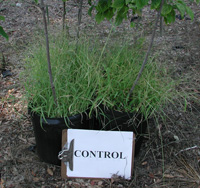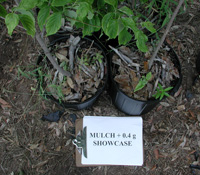Reducing Herbicide Rates in Containerized Nurseries with Allelopathic Wood Chips
Project description and objectives:
Pre and Post-emergent herbicides are commonly used for weed control in containerized woody plant nurseries. Other non-chemical weed control methods include weed discs or weed sleeves placed on the soil surface and herbicide-treated bark mulches that effectively act as slow release herbicide carriers while also reducing host plant phytotoxicity. Our recent research has also indicated that wood chips of southern red cedar and southern magnolia were as effective as applications of isoxaben/trifluralin (Snapshot).
Our objective was to determine most effective combination of allelopathic wood chip mulches and reduced herbicide rates for weed control without reducing growth of containerized woody host plants in a simulated commercial nursery.
Project activities:
Two test weed species, one dicot (redroot pigweed) and a grass (large crabgrass), were sown in nursery containers where a host plant, crape myrtle,  has already been growing. Six weed control treatments and one control treatment were applied as a randomized block (RBD) design, with three blocks per treatment and five containers per block, a total of 105 containers per experiment. The treatment included control (no herbicide or wood chips), woodchips alone, woodchips + low rate of a chemical herbicide, woodchips + high rate of a chemical herbicide, herbicide low rate alone and herbicide high rate alone. Freshly cut southern red cedar and souththern magnolia wood chips were used in comparison with a vermiculate much.
has already been growing. Six weed control treatments and one control treatment were applied as a randomized block (RBD) design, with three blocks per treatment and five containers per block, a total of 105 containers per experiment. The treatment included control (no herbicide or wood chips), woodchips alone, woodchips + low rate of a chemical herbicide, woodchips + high rate of a chemical herbicide, herbicide low rate alone and herbicide high rate alone. Freshly cut southern red cedar and souththern magnolia wood chips were used in comparison with a vermiculate much.
Project accomplishments:
Southern red cedar and souththern magnolia wood chips were as effective as the chemical weed control (isoxaben/trifluralin or Snapshot at the full rate of 0.8 g/pot) in suppressing weed growth in containerized crape myrtle. The woodchip mulches  had no inhibitory effect on the growth of crape mrytle plants. In a followup experiment southern red cedar mulch plus 2 the recommended Snapshot rate (0.4g/pot) was as effective as mulch plus the full Snapshot rate (0.8g/pot) in suppressing growth of the above weed species in containerized dogwood plants.
had no inhibitory effect on the growth of crape mrytle plants. In a followup experiment southern red cedar mulch plus 2 the recommended Snapshot rate (0.4g/pot) was as effective as mulch plus the full Snapshot rate (0.8g/pot) in suppressing growth of the above weed species in containerized dogwood plants.
Results indicate mulches of the above species are as effective as chemical control in suppressing weed growth in containerized plants over a 3-4 month period and that red cedar mulch plus reduced herbicide rates are as effective in suppressing weed growth as mulch plus a higher herbicide rate. This research also suggests that isolation of herbicidal compounds from select woody species may be useful as bioherbicides or templates for novel synthetic herbicides.
Project leaders:
- Dr. James Ferguson, Horticulturalist, University of Florida, Gainesville
- Dr. Bala Rathinasabapathi, Plant Physiologist, University of Florida, Gainesville